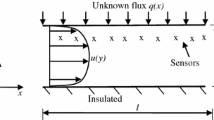Abstract
In this work, the estimation of heat flux for one-dimensional transient heat conduction problem has been done with the help of the search-based conjugate gradient method with an adjoint problem. The finite volume approach is applied to discretize the differential equations which are solved by using developed in-house MATLAB code. The novelty of this paper is justified as the required temperature data to solve the CGM algorithm are obtained by using real-time experimentation instead of performing the numerical simulation. The RMS error of the estimation of heat flow is obtained from that we can conclude that the accuracy is increased by using multiple sensors. The value of estimated heat flux is affected by the measurement errors which is inherently present in the measurement data.
Access this chapter
Tax calculation will be finalised at checkout
Purchases are for personal use only
Similar content being viewed by others
References
Weisz-Patrault D, Ehrlacher A, Legrand N (2014) Temperature and heat flux fast estimation during rolling process. Int J Therm Sci 75:1–20
Cui M, Yang K, Liu YF, Gao XW (2012) Inverse estimation of transient heat flux to slab surface. J Iron Steel Res Int 19(11):13e18
Zhou J, Zhang Y, Chen JK, Feng ZC (2010) Inverse heat conduction using measured back surface temperature and heat flux. J. Thermophys. Heat Transfer 24(1):262
Yu XC, Bai YG, Cui M, Gao XW (2013) Inverse analysis of thermal conductivities in transient non-homogeneous and non-linear heat conductions using BEM based on complex variable differentiation method. Sci. China Phys. Mech. Astron. 56(5):966–973
Lin DTW, Yang CY, Li JC, Wang CC (2011) Inverse estimation of the unknown heat flux boundary with irregular shape fins. Int J Heat Mass Transf 54(25–26):5275–5285
Lin SM (2011) A sequential algorithm and error sensitivity analysis for the inverse heat conduction problems with multiple heat sources. Appl Math Model 35(6):2607–2617. https://doi.org/10.1016/j.apm.2010.11.015
Liu FB (2011) A hybrid method for the inverse heat transfer of estimating fluid thermal conductivity and heat capacity. Int J Therm Sci 50(5):718–724
Li HQ, Lei J, Liu QB (2012) An inversion approach for the inverse heat conduction problems. Int J Heat Mass Transf 55(15–16):4442–4452. https://doi.org/10.1016/j.ijheatmasstransfer.2012.04.014
Czel B, Grof G (2012) Inverse identification of temperature-dependent thermal conductivity via genetic algorithm with cost function-based rearrangement of genes. Int J Heat Mass Transf 55(15–16):4254–4263. https://doi.org/10.1016/j.ijheatmasstransfer.2012.03.067
Cheng W, Fu CL, Qian Z (2007) A modified Tikhonov regularization method for a spherically symmetric three-dimensional inverse heat conduction problem. Math Comput Simul 75(3–4):97–112. https://doi.org/10.1016/j.matcom.2006.09.005
Liu FB (2012) inverse estimation of wall heat flux by using particle swarm optimization algorithm with Gaussian mutation. Int J Thermal Sci 54(4):62–69, 265–273. https://doi.org/10.1016/j.ijthermalsci.2011.11.013. https://doi.org/10.1016/j.ijheatmasstransfer.2012.10.036
Bideau PL, Ploteau JP, Glouannec P (2009) Heat flux estimation in an infrared experimental furnace using an inverse method. Appl Therm Eng 29(14–15):2977–2982. https://doi.org/10.1016/j.applthermaleng.2009.03.014
Deng S, Hwang Y (2007) Solution of inverse heat conduction problems using Kalman filter-enhanced Bayesian back propagation neural network data fusion. Int J Heat Mass Transf 50(11–12):2089–2100. https://doi.org/10.1016/j.ijheatmasstransfer.2006.11.019
Chang C-L, Chang M (2006) Non-iteration estimation of thermal conductivity usingfinite volume method. Int Commun Heat Mass Transfer 33(8):1013–1020
Alifanov OM (1974) Solution of an inverse problem of heat conduction by iteration methods. J Eng Phys 26:471±476
Ozisik MN, Orlande H, Kassab AJ (2002) Inverse heat transfer: fundamentals and applications. Appl Mech Rev 55(1):B18
Panchal M, Saraswat A, Verma S, Chaudhuri P (2019) Estimation of effective thermal conductivity for lithium meta-titanate (Li2TiO3) pebble beds using steady state and axial heat flow methods. J Coupled Syst Multiscale Dyn 6(4):257–265
Acknowledgements
This research work has been supported by the Board of Research in Nuclear Science (BRNS).
Author information
Authors and Affiliations
Corresponding author
Editor information
Editors and Affiliations
Rights and permissions
Copyright information
© 2021 The Author(s), under exclusive license to Springer Nature Singapore Pte Ltd.
About this paper
Cite this paper
Sathavara, P., Parwani, A.K., Panchal, M., Chaudhuri, P. (2021). Estimation of Boundary Heat Flux with Conjugate Gradient Method by Experimental Transient Temperature Data. In: Parwani, A.K., Ramkumar, P., Abhishek, K., Yadav, S.K. (eds) Recent Advances in Mechanical Infrastructure. Lecture Notes in Intelligent Transportation and Infrastructure. Springer, Singapore. https://doi.org/10.1007/978-981-33-4176-0_30
Download citation
DOI: https://doi.org/10.1007/978-981-33-4176-0_30
Published:
Publisher Name: Springer, Singapore
Print ISBN: 978-981-33-4175-3
Online ISBN: 978-981-33-4176-0
eBook Packages: EngineeringEngineering (R0)




